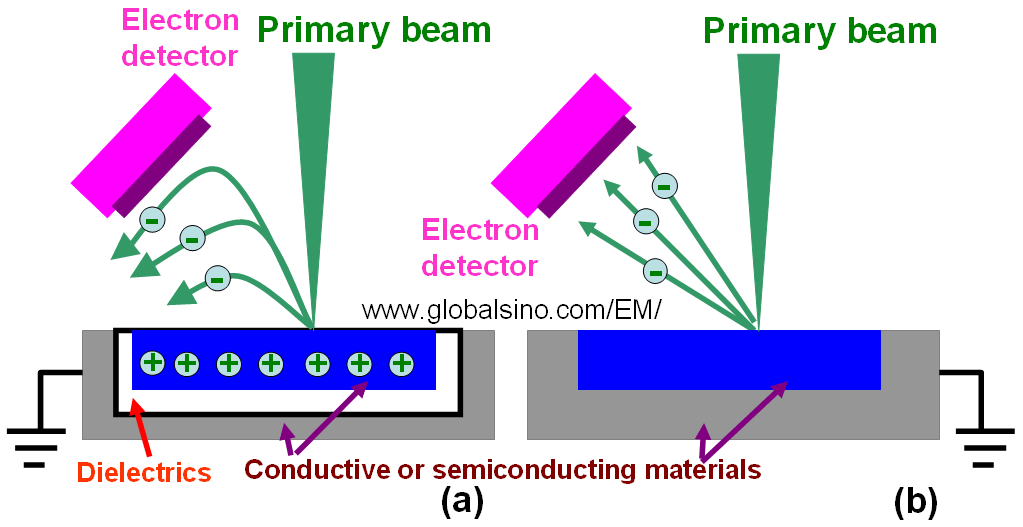=================================================================================
In the case that a positive potential (voltage) is applied to or is generated on the observing structure, not only the emission coefficient of the SEs is reduced but also the emitted SEs are retarded by the electric field similar to a potential barrier. The later phenomenon induces the emitted SEs to turn back to the surface due to attraction by the electric field.
Passive voltage contrast (PVC) method in FIBs and SEMs is widely used for failure analysis of IC chips. In FIBs this charging is always positive and mainly depends on the primary beam current. In SEMs the charging can be positive or negative depending on the energy and current of the primary electron beam.
Figure 3861 shows the case of positive charging PVC. In (a), the electrically insulated structures are charged up positively because of emission of secondary electrons (SEs) and no available electrons to compensate the electron loss. These insulated structures appear dark in the SE image because the emitted electrons can’t reach the SE detector. In (b), the grounded structure is not charged and appears bright in the SE image because of the higher SE yield and the detectable emitted electrons.

Figure 3861 Positive charging case of PVC in FIB and SEM.
The electrical potential of any observing structure can always be simplified to an equivalent circuit diagram consisting of a capacitance C and a resistance R to ground. The net current between the beam-irradiating spot and the ground is the total current (It) of the incident beam and the emitted secondary electrons (SEs). The electrical potential of the observing structure can be modified from the format presented by other authors [1] and be given by,
 -------------------------- [3861a] -------------------------- [3861a]
 -------------------------- [3861b] -------------------------- [3861b]
“-” is applied when an electron beam is used as the incident beam, while “+” is applied when a positive ion beam is used as the incident beam. The negative sign indicates that the incident electrons in SEM partially compensate or are more than the emitted SEs, resulting in less charging than that in FIB. Furthermore, the charging can be both positive and negative in SEM because the emission of SEs depends on primary beam current, accelerating voltage, structure and composition of the sample, crystalline orientation, magnification, etc. All those factors cause the PVC difference between SEM and FIB.
Furthermore, when the charging process reaches an equilibrium state, the surface potential will maintain constant. In the case of positive charging, the surface potential VS is positive a few volts, retarding the part of the SEs at low-energies and resulting in a lower SE yield. We know that the energy of the SEs is in the range of 0 to 50 eV. Therefore, only the SEs at higher energies can leave from the positive potential surface, also leading to a weaker contrast.
[1] Ruediger Rosenkranz, Failure localization with active and passive voltage contrast in FIB and SEM, J Mater Sci: Mater Electron (2011) 22:1523–1535.
|

 -------------------------- [3861a]
-------------------------- [3861a]  -------------------------- [3861b]
-------------------------- [3861b]